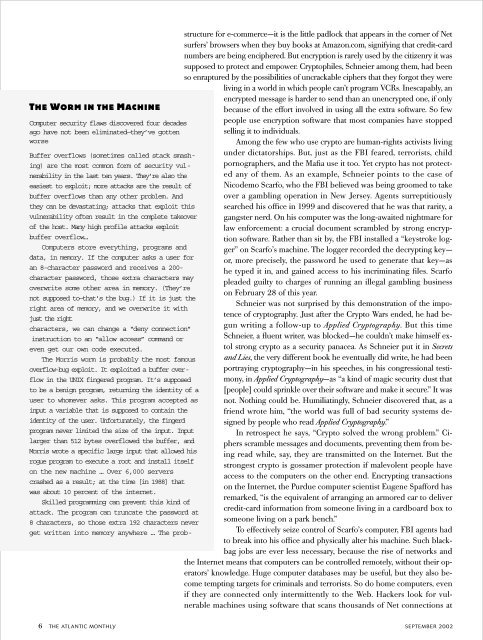HOMELAND INSECURITY - Charles C. Mann
HOMELAND INSECURITY - Charles C. Mann
HOMELAND INSECURITY - Charles C. Mann
Create successful ePaper yourself
Turn your PDF publications into a flip-book with our unique Google optimized e-Paper software.
Sept-Insecurity.pages 6/28/02 10:37 AM Page 6<br />
THE WORM IN THE MACHINE<br />
Computer security flaws discovered four decades<br />
ago have not been eliminated—they’ve gotten<br />
worse<br />
Buffer overflows (sometimes called stack smashing)<br />
are the most common form of security vulnerability<br />
in the last ten years. They’re also the<br />
easiest to exploit; more attacks are the result of<br />
buffer overflows than any other problem. And<br />
they can be devastating; attacks that exploit this<br />
vulnerability often result in the complete takeover<br />
of the host. Many high profile attacks exploit<br />
buffer overflow…<br />
Computers store everything, programs and<br />
data, in memory. If the computer asks a user for<br />
an 8-character password and receives a 200character<br />
password, those extra characters may<br />
overwrite some other area in memory. (They’re<br />
not supposed to—that’s the bug.) If it is just the<br />
right area of memory, and we overwrite it with<br />
just the right<br />
characters, we can change a “deny connection”<br />
instruction to an “allow access” command or<br />
even get our own code executed.<br />
The Morris worm is probably the most famous<br />
overflow-bug exploit. It exploited a buffer overflow<br />
in the UNIX fingered program. It’s supposed<br />
to be a benign program, returning the identity of a<br />
user to whomever asks. This program accepted as<br />
input a variable that is supposed to contain the<br />
identity of the user. Unfortunately, the fingerd<br />
program never limited the size of the input. Input<br />
larger than 512 bytes overflowed the buffer, and<br />
Morris wrote a specific large input that allowed his<br />
rogue program to execute a root and install itself<br />
on the new machine … Over 6,000 servers<br />
crashed as a result; at the time [in 1988] that<br />
was about 10 percent of the internet.<br />
Skilled programming can prevent this kind of<br />
attack. The program can truncate the password at<br />
8 characters, so those extra 192 characters never<br />
get written into memory anywhere … The prob-<br />
structure for e-commerce—it is the little padlock that appears in the corner of Net<br />
surfers’ browsers when they buy books at Amazon.com, signifying that credit-card<br />
numbers are being enciphered. But encryption is rarely used by the citizenry it was<br />
supposed to protect and empower. Cryptophiles, Schneier among them, had been<br />
so enraptured by the possibilities of uncrackable ciphers that they forgot they were<br />
living in a world in which people can’t program VCRs. Inescapably, an<br />
encrypted message is harder to send than an unencrypted one, if only<br />
because of the effort involved in using all the extra software. So few<br />
people use encryption software that most companies have stopped<br />
selling it to individuals.<br />
Among the few who use crypto are human-rights activists living<br />
under dictatorships. But, just as the FBI feared, terrorists, child<br />
pornographers, and the Mafia use it too. Yet crypto has not protected<br />
any of them. As an example, Schneier points to the case of<br />
Nicodemo Scarfo, who the FBI believed was being groomed to take<br />
over a gambling operation in New Jersey. Agents surreptitiously<br />
searched his office in 1999 and discovered that he was that rarity, a<br />
gangster nerd. On his computer was the long-awaited nightmare for<br />
law enforcement: a crucial document scrambled by strong encryption<br />
software. Rather than sit by, the FBI installed a “keystroke logger”<br />
on Scarfo’s machine. The logger recorded the decrypting key—<br />
or, more precisely, the password he used to generate that key—as<br />
he typed it in, and gained access to his incriminating files. Scarfo<br />
pleaded guilty to charges of running an illegal gambling business<br />
on February 28 of this year.<br />
Schneier was not surprised by this demonstration of the impotence<br />
of cryptography. Just after the Crypto Wars ended, he had begun<br />
writing a follow-up to Applied Cryptography. But this time<br />
Schneier, a fluent writer, was blocked—he couldn’t make himself extol<br />
strong crypto as a security panacea. As Schneier put it in Secrets<br />
and Lies, the very different book he eventually did write, he had been<br />
portraying cryptography—in his speeches, in his congressional testimony,<br />
in Applied Cryptography—as “a kind of magic security dust that<br />
[people] could sprinkle over their software and make it secure.” It was<br />
not. Nothing could be. Humiliatingly, Schneier discovered that, as a<br />
friend wrote him, “the world was full of bad security systems designed<br />
by people who read Applied Cryptography.”<br />
In retrospect he says, “Crypto solved the wrong problem.” Ciphers<br />
scramble messages and documents, preventing them from being<br />
read while, say, they are transmitted on the Internet. But the<br />
strongest crypto is gossamer protection if malevolent people have<br />
access to the computers on the other end. Encrypting transactions<br />
on the Internet, the Purdue computer scientist Eugene Spafford has<br />
remarked, “is the equivalent of arranging an armored car to deliver<br />
credit-card information from someone living in a cardboard box to<br />
someone living on a park bench.”<br />
To effectively seize control of Scarfo’s computer, FBI agents had<br />
to break into his office and physically alter his machine. Such blackbag<br />
jobs are ever less necessary, because the rise of networks and<br />
the Internet means that computers can be controlled remotely, without their operators’<br />
knowledge. Huge computer databases may be useful, but they also become<br />
tempting targets for criminals and terrorists. So do home computers, even<br />
if they are connected only intermittently to the Web. Hackers look for vulnerable<br />
machines using software that scans thousands of Net connections at<br />
6 THE ATLANTIC MONTHLY SEPTEMBER 2002




